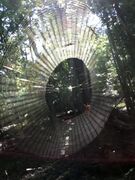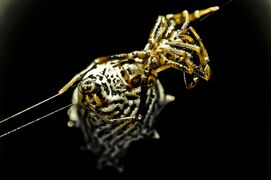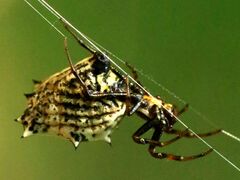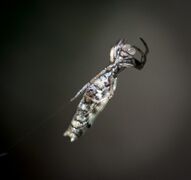Biology:Spined micrathena
| Spined micrathena | |
|---|---|

| |
| Scientific classification | |
| Domain: | Eukaryota |
| Kingdom: | Animalia |
| Phylum: | Arthropoda |
| Subphylum: | Chelicerata |
| Class: | Arachnida |
| Order: | Araneae |
| Infraorder: | Araneomorphae |
| Family: | Araneidae |
| Genus: | Micrathena |
| Species: | M. gracilis
|
| Binomial name | |
| Micrathena gracilis (Walckenaer, 1805)[1]
| |
| Synonyms[1] | |
| |
Micrathena gracilis is a spider in the family Araneidae (orb-weavers),[1] commonly known as the spined micrathena[2] or castleback orbweaver.[3] This spider spins a moderately large (can be about 20 cm long in diameter) and very tightly coiled web. The spiders themselves are small and can be found to be anywhere from 4.2 mm to 10.8 mm long.[4] Its venom is harmless to humans. M. gracilis is unique in appearance due to its large spiky abdomen and black and white bodies. Certain spiders of this species can also display a yellow color on the sides of their bodies.[5] These spiders can be seen most active during the end of the summer and beginning of fall. M. gracilis is diurnal and are rarely ever seen active at night.[6]
Physical characteristics
Females are 8–10 mm long. They exhibit a bulbous abdomen with spines. Males exhibit a fair amount of sexual dimorphism. They tend to be a fraction of the size of the females. Also, they have fewer spines, a flatter abdomen, and a slightly lighter tone. Although males can produce silk, they mostly use it in the mating ritual.
Webs
When constructing webs, the inner orbs of their webs are changed every night; however, they may keep the outer layer of the web the same for multiple days.[6]
Distribution and habitat
Micrathena gracilis is native to North and Central America.[1] These spiders tend to wander and rarely ever remain in the same web site for more than week. On average, they spend about 6–7 days on each web site. They are neotropical forest spiders and can be found more easily in hardwood forests that contain Oak and Hickory trees. They tend to like moisture; they are more easily found in woodland forests that are near a lagoon, pond, or other small bodies of water. One study mentioned that these spiders were found in an area that tends to flood during their mating season.[7] M. gracilis may also coexist within and along the edges of colonies of Metepeira incrassata, also known as the colonial orb-weaving spider.[8] They prey on the skimming bluet and are in turn eaten by white-eyed vireos.[2]
Life cycle
Micrathena gracilis hatches in the spring, the image of an adult. After the summer's growth, the female lays eggs in a sac. These remain relatively dormant through the winter months. The general life span is one year in length.
References
- ↑ 1.0 1.1 1.2 1.3 "Taxon details Micrathena gracilis (Walckenaer, 1805)", World Spider Catalog (Natural History Museum Bern), https://www.wsc.nmbe.ch/species/4733, retrieved 2020-10-25
- ↑ 2.0 2.1 "Spined Micrathena - Encyclopedia of Life". https://eol.org/pages/1195786.
- ↑ Nguyen, Vy (2022-04-13). "22 Common Types of Orb Weavers (Pictures and Identification)" (in en-US). https://thepetenthusiast.com/types-of-orb-weavers/.
- ↑ McCravy, Kenneth (2012). "Abundance and web characteristics of Micrathena gracilis and Micrathena mitrata (Araneae: Araneidae) in west-central Illinois, USA". Journal of Arachnology 40 (2): 215–217. doi:10.1636/p11-85.1. https://www.biodiversitylibrary.org/part/229364.
- ↑ Vanderhoff, Natasha (November 2008). "Do the Color and Pattern of Micrathena gracilis (Araneae: Araneidae) Attract Prey? Examination of the Prey Attraction Hypothesis and Crypsis". Journal of Insect Behavior 21 (6): 469–475. doi:10.1007/s10905-008-9142-3.
- ↑ 6.0 6.1 Magalhães, Ivan L. F.; Santos, Adalberto J. (August 2012). "Phylogenetic analysis of Micrathena and Chaetacis spiders (Araneae: Araneidae) reveals multiple origins of extreme sexual size dimorphism and long abdominal spines: PHYLOGENY OF MICRATHENA AND CHAETACIS". Zoological Journal of the Linnean Society: no. doi:10.1111/j.1096-3642.2012.00831.x.
- ↑ Bukowski, Todd C.; Christenson, Terry E. (1997). "Natural History and Copulatory Behavior of the Spiny Orbweaving Spider Micrathena gracilis (Araneae, Araneidae)". The Journal of Arachnology 25 (3): 307–320. ISSN 0161-8202.
- ↑ Hodge, Margaret A.; Uetz, George W. (September 1996). "Foraging advantages of mixed-species association between solitary and colonial orb-weaving spiders" (in en). Oecologia 107 (4): 578–587. doi:10.1007/BF00333951. ISSN 0029-8549. PMID 28307403. http://link.springer.com/10.1007/BF00333951.
External links
| Wikimedia Commons has media related to Micrathena gracilis. |
- Spined Micrathenas (Fairfax County Public Schools site)
- Spined Micrathena - diagnostic photographs
- Spined Micrathena
- Pictures of M. gracilis
- Illinois State Museum's spider collection
Wikidata ☰ Q2380631 entry
 |






